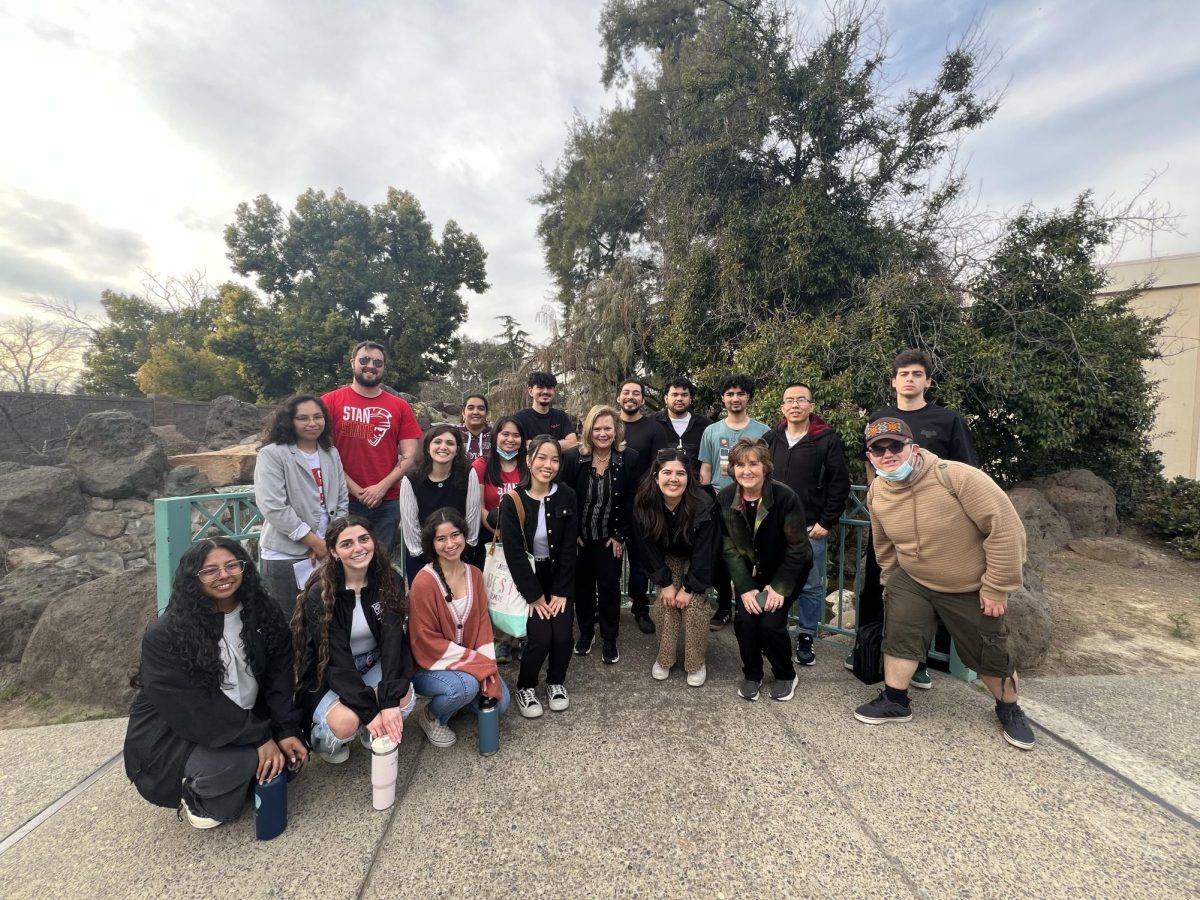Pokémon GO is a mobile app game conceived by Nintendo and The Pokémon Company International and created by Niantic Inc. that took the world by storm when it was released on July 6, 2016.
Soon after its release, hundreds of students could be seen roaming California State University, Stanislaus (Stan State) hunting for Pokémon through their phone screens in the first-ever highly successful augmented reality game.
Players are able move their avatars virtually by walking around in real life. Pokémon “spawn,” or appear, on the screen, and players can use their cameras to view these Pokémon and catch them. Players can use their Pokémon to battle and “capture” gyms. PokéStops are locations that have significance in the real world, such as murals, statues and storefronts, where players can collect items such as Pokéballs, which are used to capture Pokémon.
The game’s map looks very similar to Google Maps, which is no surprise since the idea for Pokémon GO originated from the Google Maps: Pokemon Challenge April Fool’s joke in 2014.
The Pokémon Company, Game Freak, Nintendo and Google collaborated to create a search-and-find game where users could search for Pokémon sprites on Google Maps to “catch ’em all.” The popularity of the prank encouraged the creation of Pokémon GO.
Pokémon GO has affected every aspect of the Stan State community, from the Associated Students Incorporated (ASI) to students and even professors.
“We were very excited [when the game came out]. We caught a few [Pokémon], and it was fun,” says Professor Lunt.
“We decided, ‘Hey, let’s go to the campus. I bet there’s a lot of stuff there,’ and there was,” says Professor Lunt’s daughter, Margaret Lunt (junior, Art).
“And we saw a lot of other people doing the same thing,” continued Professor Lunt.
While some find Pokémon GO to be a great social tool, others believe it is a distraction from school.
“People are concentrating more on the game itself. When they’re walking, they’re just paying attention to their phones and not their surroundings,” Adrianna Aguilar (junior, Communications) said.
Professor Lunt says that she has not had this issue within her classrooms since she has a no-phone policy for her classes. However, her daughter admits that she has snuck out her phone in order to play the game during class before.
“I’ve seen people playing in class, even with no-cell-phone policies,” says Margaret Lunt. She explained that she has never gotten caught for playing the game in class.
“I don’t do it too often. I do it in [one of my classes] just ’cause there are three PokéStops right there where I sit. I do it maybe once a class and if it’s a slow class.”
On the other hand, ASI is using the addictive game as a marketing strategy. On August 30, ASI welcomed students back with a Pokémon GO event where students could go to several tented locations on campus and enter in a raffle to win hats denoting each rival team: Valor, Mystic and Instinct. There was also a raffle to win a hat from the Pokémon anime series.
“It was a lot of fun being able to bond with people I’ve never met before over this game,” said Mario Muñiz, (senior, Computer Science) who helped put on the ASI event.
Several clubs and Greek organizations have also been able to recruit new members thanks to the game. Alpha Phi Omega members wore Pokémon shirts from their Pokémon rush event last semester and spoke to passersby at New Student Orientation and the Freshman Convocation Ceremony this past summer about doing a future Pokémon GO event.
They also set down a “lure,” a device in the game that attracts Pokémon, at a PokéStop nearest to their Greek table to lure students over to catch a conversation with APO members, while catching Pokemon.
After the release of the game, the campus was crawling with Pokémon “trainers” trying to fill up their Pokédexes in order to fight against other teams and claim the various gyms found on campus.
“At one point in time, I saw probably over a hundred people playing the game on campus after 10 p.m.,” said Muñiz.
A couple month’s after the game’s release, the application’s popularity has declined and people have different speculations as to why this might be.
“I think it can be dangerous,” said Professor Lunt, who took note of the controversial issues arising from the game when players were “lured” into traps where their phones would get stolen. According to several news media outlets, some players came across dead bodies while they were playing, and some players were even killed themselves.
“I don’t think it’s dangerous,” says Margaret Lunt. She believes that players just need to have common sense in order to stay safe.
On Sept. 30, the Pokémon GO website posted safety tips for their users, and the company has updated their app to occasionally remind players of these tips when they start up the game. Some tips include alerts stating that the player should not be playing while driving and to be aware of their surroundings.
The new Pokémon GO Plus was released on Sept. 16. It is a portable device that allows players to use the game without having to use their mobile devices.
A player is alerted of nearby Pokémon and PokéStops by a flashing LED light on the device and a vibration. Players can then press the button on the device to collect items and catch Pokémon without having to use a mobile device. You can find out if your smartphone is compatible with the Pokémon GO Plus here.
Now that the Pokémon GO Plus has been released, a new surge in popularity for the game is expected to follow. Perhaps a new surge in Pokémon GO activity at Stan State should be around the corner, as well.
Categories:
“Catching ’em all” imposes risks with high popularity
Tatiana Olivera
•
October 27, 2016
Mario Muñiz (senior, Computer Science) plays Pokémon GO on the first day of its release in San Francisco. (The Signal/Tatiana Olivera)
0
Donate to Signal
Your donation will support the student journalists of California State University, Stanislaus. Your contribution will allow us to purchase equipment and cover our annual website hosting costs.
More to Discover



















